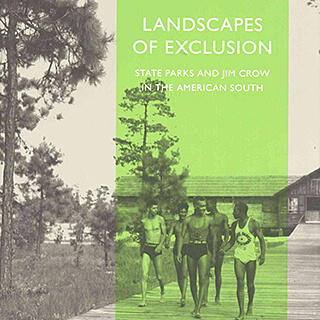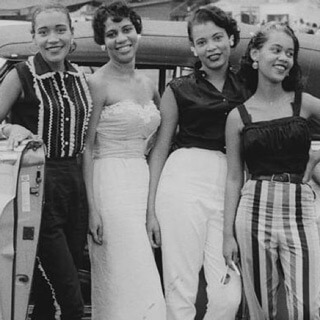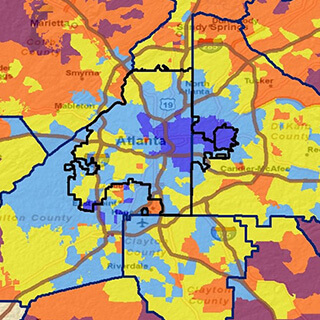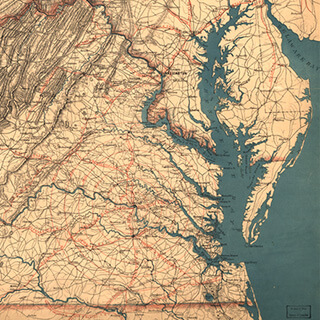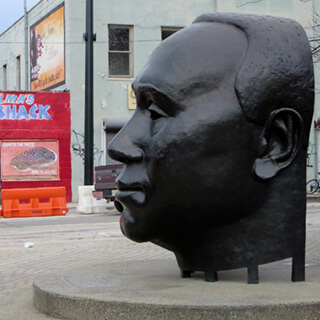Overview
In this excerpt from Traveling Black: A Story of Race and Resistance (Harvard University Press, 2021), Mia Bay explores the intertwined history of travel segregation and Black struggles for freedom of movement in the US through the oppressive architecture of train stations.
Excerpt: "Jim Crow Journeys"

The humiliations involved in traveling Jim Crow began before Black travelers even boarded their trains. By the beginning of the 1890s the proliferation of separate car laws had ushered in separate waiting rooms. Although before 1899 only Arkansas, Louisiana, and Mississippi had passed laws requiring the railroads to construct segregated facilities, colored waiting rooms were common across the South well before then. Writing in 1891, Black academic William Scarborough described one of the New South's most unpleasant innovations as the "the novelty of three waiting rooms—one for ladies, one for gentlemen, and one for neither gentlemen nor ladies, but for 'negroes.'" That Negroes were "neither ladies nor gentlemen" was a point that could be inferred from the conditions in these new spaces. "The negro-waiting room is a dirty miserable place, with here or there a broken chair and [a] few miserable benches," wrote Scarborough of the accommodations that he had seen in Chattanooga, Atlanta, Macon, and elsewhere.1"A Step Backward," Frank Leslie's Illustrated Newspaper, September 19, 1891, 98.
Built and maintained by the railroads, colored waiting rooms were sometimes created as a result of new construction and sometimes added to existing structures; but they were almost always smaller, less comfortable, and less convenient than the facilities available to whites. Black novelist Charles Chesnutt noted in an article written in 1901, "If there is any choice of location" when it came to positioning such rooms, "the Negro always gets the worst room and it is seldom well lighted or clean."2Charles W. Chesnutt, "The White and the Black," Boston Evening Transcript, March 20, 1901, 13.
The "Colored Waiting Room" in Seaboard Air Line and Southern Railway Depot in Raleigh, North Carolina, provides one example of the kind of facility he had in mind.3Founded in 1900 and headquartered in Norfolk, Virginia, the Sea Board Air Line Railway ran along the South's eastern coast, terminating in Florida. Despite its name, it owned no airplanes. Before the days of air travel, "air line" (as in a straight line drawn in the air) was a term widely used to describe the shortest distance between two points, and it became part of the name of a number of nineteenth-century railroads whose proprietors wished to emphasize that their routes were more direct than those of competing roads. Black travelers described it in a discrimination complaint filed before the North Carolina Board of Railroad Commissioners in 1898 as "the most poorly equipped room at the depot, being dark and ill ventilated," and "very inferior" to the waiting room used by the station's white passengers. Small and cramped, it seated only twelve people, and one of its rows of seats was located "within a few feet of its restrooms" and faced directly into these facilities. Travelers who sat in these seats had an unavoidable view of "people going in and out the urinals and stalls," and were close enough to be able to smell the bathrooms as well. These busy bathrooms were used not just by colored travelers, but by railroad hands and "the public around the depot, ad libitum," so the stench that they gave off during warm weather assaulted not only the people in nearby seats, but everyone in the waiting room.4"E. A. Johnson, John Dancy, R. H. W. Leak et al. vs. Seaboard Airline and Southern Railroad," in Eighth Annual Report of the Board of Railroad Commissioners of North Carolina (Raleigh: Guy V. Barnes, Printer to the State, 1898), 110.
Conditions in the station's colored waiting room were especially troubling to Black women passengers, whose race exempted them from the privileges usually accorded to female travelers. The Raleigh station had no ladies' waiting room for Black women, who were "not allowed to go into the general ladies' waiting room." They, too, had to occupy Raleigh's tiny, smelly "colored waiting room" and experience its bird's-eye view of the toilet. "Convicts and insane people" were among the travelers who used these rooms, the complainants charged, and "the seats are so arranged that when such people are in there, lady passengers must sit next to them or immediate back of them."5"E. A. Johnson, John Dancy, R. H. W. Leak et al. vs. Seaboard Airline and Southern Railroad."

Raleigh's small station was built nearly a decade before North Carolina passed its 1899 law requiring the establishment of separate waiting rooms for white and colored races, and may have had an especially cramped colored waiting room for that reason. But southern railroads designed with segregation in mind were often equally problematic. Completed in 1906, Atlanta's massive Terminal Station replaced an older station and provided more spacious accommodations for Blacks. The station it replaced had only two waiting rooms: a general "Waiting Room for Ladies and Gentlemen," and smaller "Colored Waiting Room" that had once served as its "Ladies' Waiting Room."6Chesnutt, "The White and the Black," 13.
Still, most Blacks probably preferred the old station to the palatial new building. The "whole front" of the new station, according to journalist Ray Stannard Baker, "was given up to white people."7Ray Stannard Baker, Following the Color Line: An Account of Negro Citizenship in the American Democracy (New York: Doubleday, 1908), 223. Its facilities included a grand main waiting room, several ladies' waiting rooms, a gentlemen's reading room, a gentlemen's smoking room, and exactly one waiting room for Blacks—a "small and dirty room" that had to be entered from the side of the building.8"Atlanta Terminal of the Southern Railway," International Railway Journal 8, no. 5 (August 1905): 17. The size, location, and unkempt state of the Terminal's colored waiting room were the result of deliberate decisions made by the railroads that built and maintained the facility. Even the dirt served to underscore the racial hierarchies inscribed in the nation's architecture. When asked why the room was so filthy, the Black porter explained he "was expected not to keep the Negro waiting rooms as clean as the one for whites. The differential had to be maintained."9 Benjamin Mays, Born to Rebel: An Autobiography (New York: Scribner, 1971; Athens, GA: University of Georgia Press, 2003), 78. Differential access was also maintained. The only Blacks permitted to pass through the station's white waiting rooms were redcaps, servants, and porters. Black travelers who used the station had to enter and exit the facility through their "dirty little segregated room," which was situated on a side street more than a hundred feet away from the station's main entrance and taxi stands.
The stationmaster who imposed this policy was "no respecter of persons," according to Baptist minister Benjamin Mays, who lived in Atlanta for much his life. "He treated all Negroes with equal disrespect," preventing Black celebrities such as Marian Anderson from passing through the station's front doors and even extending the ban to a white woman, Florence Reed, whom he considered "contaminated because she was the president of Spelman Negro College." Black college president Rufus E. Clement was even more unwelcome: in the 1940s, a station policeman threatened to shoot him "for the heinous crime of having walked through the white room to the train to avoid having to walk outside in the rain as would have been necessary to get to the Negro waiting room."10Mays, Born to Rebel, 79.
Although far larger than most southern railway stations, Atlanta's Terminal Station was not unusual in its design. Most stations built during the segregation era routed Black travelers through separate entrances. Completed in 1899, Forsyth Station, also in Georgia, was typical in its design. Its small colored waiting room was completely cut off from the rest of the station. It had a front door that opened directly onto the street, and a side door through which Black passengers could access the tracks, but no door connecting it to the station's main waiting room. The only space the station's Black travelers shared with their white counterparts was the station's ticket office, which had a ticket window that opened into the station's colored waiting room.

The fact that most railroads had a single ticket booth with segregated ticket windows was less innocuous than it might seem.11A Florida statute passed in 1907 required "Separate Waiting Rooms and Ticket Windows," The Compiled Laws, 1914, of the State of Florida (St. Paul, FL: West, 1915), 2960e. The railroad employees who worked the ticket booths served both windows, but routinely made African American ticket buyers wait until they had finished serving customers on the white side of the booth, regardless of how long their Black customers had been waiting. As a result, however early Black travelers arrived at the train station, they sometimes found themselves forced to purchase their "tickets moments before their train pulled out."12Joan Steinau Lester, Eleanor Holmes Norton: Fire in My Soul (New York: Simon and Schuster, 2003), 24. Sometimes the wait could be fruitless, for by the time the "tired ticket agent" began to serve Black customers, "often there was no time to buy [a] ticket and if they did not get them they had to pay extra on the train." Some unfortunate travelers waited so long at the ticket window that they missed their trains altogether, and even those who managed to secure a ticket could leave the window "burning with indignation and hatred."13W. E. B. Du Bois, "On Being Black," New Republic, 21, no. 272, February 18, 1920.
Such emotions were unlikely to abate as Jim Crow travelers progressed on to their destinations. White railroad station personnel were rude to Blacks, who rarely received assistance getting on or off the train and could not count on help carrying their baggage. Even at small stations with no platforms—where passengers typically disembarked "stepping on the narrow little stool placed under by the conductor"—Black women could not count on assistance from these officials, noted the Black writer Anna Julia Cooper in 1892. Instead, "gentlemanly and efficient" railroad conductors would hand "[white] woman after [white] woman from the steps to the stool, thence to the ground, or else relieving her of satchels and bags and enabling her to make the descent easily." But when "the Black Woman's turn came to alight" these men "would deliberately fold their arms and turn round."14Anna Julia Cooper, A Voice from the South (Xenia, OH: Alpine Printing House, 1892), 90. And as the Jim Crow car became entrenched, Black passengers lost access to the step. At small stations, according to W. E. B. Du Bois, southern railroads began to stop the Jim Crow car, which was invariably the first passenger car, "out beyond the covering in the rain or sun or dust," and require Black passengers to climb on and off without even providing a step.15Du Bois, "On Being Black."
African American travelers who boarded trains in the North often experienced similar rudeness well before they crossed the Mason-Dixon Line. Cairo, Illinois, along with Cincinnati, Ohio, and Washington, DC, were all stops where conductors began to force African American passengers to move from regular seats to seats in the Jim Crow car—often with no grace whatsoever. One Black traveler complained in a 1946 letter to the Chicago Defender that when Illinois Central Railroad trains passed through Cairo, conductors sometimes pushed "women and children around as if they were beasts," addressing them as "'nigger' girls and 'nigger' boys" and telling them they had to move to "the 'nigger' coach."16"Tells of Jim Crow by Railroad," Chicago Defender, October 5, 1946, 14. Complaints about being Jim Crowed in Cairo, Illinois, go as far back as the World War I era. See, for example, "Jim Crow in Illinois," Chicago Defender, July 18, 1914, 8; "Ill. Central Mistreats Colored Passengers," Chicago Defender, September 5, 1914, 1. Likewise, in Cincinnati and Washington, conductors "hollered (under their breath of course) 'Every pig to his pen,' or words to that effect."17"Dan Burley's Back Door Stuff: Looking through the Window of a Jim Crow Train," New York Amsterdam News, November 13, 1943, 8B.
The rudeness continued inside the Jim Crow car. "The conductor appropriates two seats for himself and his papers and yells gruffly for your tickets almost before the train has started," wrote Du Bois, describing race relations in a typical Jim Crow car: "It is best not to ask him for information even in the gentlest tones. His information is for white persons chiefly." The other whites who made themselves at home in these cars were equally discourteous, at least according to Du Bois, who especially disliked the "impertinent white newsboy" who always occupied "two seats at the end of the car and importunes you to the point of rage to buy cheap candy, Coca-Cola, and worthless, if not vulgar, books."

White rudeness, however, was not the most pressing issue that Black passengers faced. Colored waiting rooms often had no heat, and many Jim Crow cars had "no fire" even on the "coldest days." Food was even more of a problem. Few Jim Crow waiting rooms had restaurants, snack bars, or any place where Black travelers could purchase "the refreshments to be found in the big main waiting room."18Langston Hughes, "From Rampart Street to Harlem, I Follow the Trail of the Blues," (December 6, 1952), in The Collected Writings of Langston Hughes, vol. 10: Fight for Freedom and Other Writings on Civil Rights (Columbia: University of Missouri Press, 2001), 245. Nor could African Americans count on being able to buy food once onboard the trains. First introduced on Pullman's Palace sleeping cars in the 1860s, dining cars by the beginning of the twentieth century were all but ubiquitous on long-distance routes. They were designed to offer travelers an attractive alternative to railroad station restaurants, where meals were often hurried and unappealing. But in the South, railroad dining cars were subject to state segregation laws that put them off-limits to Black customers.
While stationary restaurants were free to cater to an exclusively white or Black clientele, railroads and other common carriers were supposed to offer separate but equal facilities to Blacks and whites. They rarely did so, and would have faced insurmountable challenges had they tried to do so, as railroad food services were subject to both restaurant and transportation laws—which were not necessarily complementary or even compatible. On southern trains, any shared coach was to be "divided by a partition, designated for the race to which such passenger belongs," while restaurants were subject to still more stringent regulations.19The Code of Alabama: Adopted by Act of the General Assembly . . . Approved February 16, 1897, prepared by William Logan Martin (Atlanta, GA: Foote and Davies, 1887), chap. 95, art. 2, 3455, p. 975. In Birmingham, Alabama, for instance, facilities that served food could not accommodate Blacks and whites in the same room—unless, as the municipal legislators put it, "such white and colored persons are effectually separated by a solid partition extending from the floor upward to a distance of seven feet or higher, and unless a separate entrance from the street is provided for each compartment."20The General Code of the City of Birmingham, Alabama, of 1930: (Includes All Ordinances of a General and Permanent Nature except as Specified in Sec. 6113). (Birmingham Printing Company, 1930), 215.
The logistics of dining car service made it impossible to fit all of these requirements, and none of the railroads were willing to operate two dining cars. So they adopted a variety of ways to divide up Black and white diners, ranging from excluding Blacks from food services entirely, to creating segregated seating within their dining compartments, to seating African American diners only after all their white passengers had finished eating, to having waiters and other railroad food service personnel take food to the colored car.

In the South the worst of these arrangements usually prevailed. "It can be flatly stated that it is impossible for the Negro to get dining car privileges South of Washington," wrote Howard professor Thomas Montgomery Gregory after completing an investigation of travel segregation for the NAACP in 1916. Gregory came to this conclusion after traveling from New Orleans to Washington on a halting, roundabout trip that took thirty hours, while subsisting on nothing but Coca-Cola. Confined to the Jim Crow car, he had no access to his train's dining car and "the stopovers at stations were not long enough to procure food at the stations if any was provided there for Negroes." Furious, he concluded that "it is not sufficient to say that I should have to take food with me or that I should have lived on grapes and peanuts. If I am to have equal accommodations, I should be able to secure palatable food served in a proper manner."21Thomas Montgomery Gregory, "The Jim-Crow Car: An N.A.A.C.P. Investigation, Part III," Crisis, February 1916, 196.
Gregory's experience was not unusual. Even when Black passengers could purchase food, their options were limited. William Pickens's experience on a ride from Lynchburg to Norfolk, in Virginia, in 1920 was fairly typical. Barred from dining car service, his only hope of food came when the train made a twenty-minute stop in Petersburg to allow white passengers who were "too stingy to pay for dining service and tips" to grab a quick meal at the station's lunch counter. At the end of their meals, just as the train resumed its journey, the lunch counter's staff sent out a basket full of cold leftover food, "which could never be sold to white customers, in an effort to get rid of it among the colored passengers." The food they sent, Pickens noted bitterly, only added "indigestion to insult." For seventy-five cents, you could get "a quarter of an impenetrable dried hen fried the day before yesterday, old bread and a slice of musty pie," whereas "the white passengers in the lunch room may get a hot drink or a fried egg for a few cents." The passengers who bought the overpriced food could not even secure cutlery or any beverages with their meals, as railroad employees were not allowed to bring dishes or flatware into the colored car.22 William Pickens, "Jim-Crowed," Socialist Review 9, no. 2 (1920): 126.
When railroads crossing through the segregated states did open up their dining rooms to Black customers, they observed the requirements of segregation law either by holding a separate seating for Black diners after white diners had eaten, or by setting aside a small number of special tables for Black customers, partitioned off by a curtain—an experience that Blacks found truly humiliating. "The first time that I was seated behind a curtain in a dining car, I felt as if the curtain had been dropped on my selfhood," Martin Luther King Jr. recalled in his autobiography, describing it as one of the moments in which he realized, "I could never adjust to the separate waiting rooms, separate eating places, separate rest rooms, partly because the separate was always unequal, and partly because the very idea of separation did something to my sense of dignity and self-respect."23"Chapter 1: Early Years," The Autobiography of Martin Luther King, Jr., ed. Clayborne Carson, https:// kinginstitute.stanford.edu/king-papers/publications/autobiography-martin-luther-king-jr-contents/chapter-1-early-years. 
Excerpted from TRAVELING BLACK: A STORY OF RACE AND RESISTANCE by Mia Bay, published by Harvard University Press. Copyright © 2021 by the President and Fellows of Harvard College. Used by permission. All rights reserved.
About the Author
Mia Bay is the author of To Tell the Truth Freely: The Life of Ida B. Wells (Farrar, Straus and Giroux, 2009) and The White Image in the Black Mind (Oxford University Press, 2000), and coauthor of Freedom on My Mind: A History of African Americans, with Documents (Bedford/St. Martin's, 2012). She is the Roy F. and Jeannette P. Nichols Professor of American History at the University of Pennsylvania.
Cover Image Attribution:
Union Terminal railroad depot concourse, Jacksonville, Florida, 1921. Photograph by Woodward Studio. Courtesy of Florida Memory, State Library and Archives Florida. Image is in public domain.Recommended Resources
Text
Hale, Grace Elizabeth. "Segregation and Train Travel." In The New Encyclopedia of Southern Culture: Volume 24: Race, edited by Thomas C. Holt, Laurie B. Green, and Charles Reagan Wilson, 247–49. Chapel Hill: University of North Carolina Press, 2013.
Perman, Michael. Struggle for Mastery: Disfranchisement in the South, 1888–1908. Chapel Hill: University of North Carolina Press, 2001.
Sorin, Gretchen. Driving While Black: African American Travel and the Road to Civil Rights. New York: Liveright Publishing Corporation, 2020.
Taylor, Candacy. Overground Railroad: The Green Book and the Roots of Black Travel. New York: Abrams Press, 2020.
Welke, Barbara Young. Recasting American Liberty: Gender, Race, Law, and the Railroad Revolution, 1865–1920. New York: Cambridge University Press, 2001.
Web
Foo, Brian. "Navigating the Green Book." New York Public Library Digital Collections. Accessed May 26, 2021. https://publicdomain.nypl.org/greenbook-map/.
"The Green Book." New York Public Library Digital Collections. Accessed May 26, 2021. https://digitalcollections.nypl.org/collections/the-green-book#/?tab=about.
"Green Book Sites: A Historic Travel Guide to Jim Crow America." National Trust for Historic Preservation. Accessed May 26, 2021. https://savingplaces.org/green-book-sites.
Sandoval-Strausz, A.K. "Travelers, Strangers, and Jim Crow: Law, Public Accommodations, and Civil Rights in America." Law and History Review 23, no. 1 (2005): 53–94. DOI: https://doi.org/10.1017/S0738248000000055.
Similar Publications
| 1. | "A Step Backward," Frank Leslie's Illustrated Newspaper, September 19, 1891, 98. |
|---|---|
| 2. | Charles W. Chesnutt, "The White and the Black," Boston Evening Transcript, March 20, 1901, 13. |
| 3. | Founded in 1900 and headquartered in Norfolk, Virginia, the Sea Board Air Line Railway ran along the South's eastern coast, terminating in Florida. Despite its name, it owned no airplanes. Before the days of air travel, "air line" (as in a straight line drawn in the air) was a term widely used to describe the shortest distance between two points, and it became part of the name of a number of nineteenth-century railroads whose proprietors wished to emphasize that their routes were more direct than those of competing roads. |
| 4. | "E. A. Johnson, John Dancy, R. H. W. Leak et al. vs. Seaboard Airline and Southern Railroad," in Eighth Annual Report of the Board of Railroad Commissioners of North Carolina (Raleigh: Guy V. Barnes, Printer to the State, 1898), 110. |
| 5. | "E. A. Johnson, John Dancy, R. H. W. Leak et al. vs. Seaboard Airline and Southern Railroad." |
| 6. | Chesnutt, "The White and the Black," 13. |
| 7. | Ray Stannard Baker, Following the Color Line: An Account of Negro Citizenship in the American Democracy (New York: Doubleday, 1908), 223. |
| 8. | "Atlanta Terminal of the Southern Railway," International Railway Journal 8, no. 5 (August 1905): 17. |
| 9. | Benjamin Mays, Born to Rebel: An Autobiography (New York: Scribner, 1971; Athens, GA: University of Georgia Press, 2003), 78. |
| 10. | Mays, Born to Rebel, 79. |
| 11. | A Florida statute passed in 1907 required "Separate Waiting Rooms and Ticket Windows," The Compiled Laws, 1914, of the State of Florida (St. Paul, FL: West, 1915), 2960e. |
| 12. | Joan Steinau Lester, Eleanor Holmes Norton: Fire in My Soul (New York: Simon and Schuster, 2003), 24. |
| 13. | W. E. B. Du Bois, "On Being Black," New Republic, 21, no. 272, February 18, 1920. |
| 14. | Anna Julia Cooper, A Voice from the South (Xenia, OH: Alpine Printing House, 1892), 90. |
| 15. | Du Bois, "On Being Black." |
| 16. | "Tells of Jim Crow by Railroad," Chicago Defender, October 5, 1946, 14. Complaints about being Jim Crowed in Cairo, Illinois, go as far back as the World War I era. See, for example, "Jim Crow in Illinois," Chicago Defender, July 18, 1914, 8; "Ill. Central Mistreats Colored Passengers," Chicago Defender, September 5, 1914, 1. |
| 17. | "Dan Burley's Back Door Stuff: Looking through the Window of a Jim Crow Train," New York Amsterdam News, November 13, 1943, 8B. |
| 18. | Langston Hughes, "From Rampart Street to Harlem, I Follow the Trail of the Blues," (December 6, 1952), in The Collected Writings of Langston Hughes, vol. 10: Fight for Freedom and Other Writings on Civil Rights (Columbia: University of Missouri Press, 2001), 245. |
| 19. | The Code of Alabama: Adopted by Act of the General Assembly . . . Approved February 16, 1897, prepared by William Logan Martin (Atlanta, GA: Foote and Davies, 1887), chap. 95, art. 2, 3455, p. 975. |
| 20. | The General Code of the City of Birmingham, Alabama, of 1930: (Includes All Ordinances of a General and Permanent Nature except as Specified in Sec. 6113). (Birmingham Printing Company, 1930), 215. |
| 21. | Thomas Montgomery Gregory, "The Jim-Crow Car: An N.A.A.C.P. Investigation, Part III," Crisis, February 1916, 196. |
| 22. | William Pickens, "Jim-Crowed," Socialist Review 9, no. 2 (1920): 126. |
| 23. | "Chapter 1: Early Years," The Autobiography of Martin Luther King, Jr., ed. Clayborne Carson, https:// kinginstitute.stanford.edu/king-papers/publications/autobiography-martin-luther-king-jr-contents/chapter-1-early-years. |


